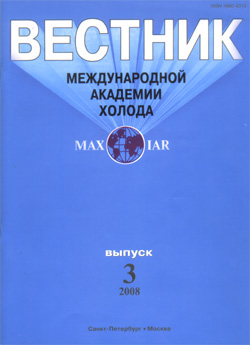
Heat transfer intensity of heat exchangers with plate fins

Annotation
Plain fin-and-tube heat exchangers are preferred for operation in conditions of frost formation, moisture, or contamination on the outer surface. They are distinguished by a variety of design and operating parameters. For the design, selection, and analysis of the characteristics of such heat exchangers, reliable data on the intensity of heat transfer are required. During the preparing of this article, a review of existing approaches to determining the intensity of heat transfer in heat exchangers was made; available experimental data with the conditions for experiments were collected; frequently cited techniques for calculating heat transfer rates were analyzed; Nusselt numbers were calculated using various methods with the initial data given in the sources with the experimental data. In order to incorporate more experimental data, dry heat transfer processes were analyzed. From the experimental data on the study of heat transfer during the formation of condensate or a layer of frost, only processes with a moisture loss coefficient of not more than 1.0 were selected. Due to the fact that none of the techniques showed a good agreement between the calculated and experimental data in a wide range of design and operating parameters of heat exchangers, a regression analysis of the experimental data was performed in their entire range. Acceptable indicators of approximation accuracy are provided by five regression equations with the number of influencing variables from 3 to 7. For each of them, which has the form of a product of dimensionless quantities with their rate, specific expressions and exponents are given. The need for further improvement of methods for calculating and accumulating experimental data on heat transfer for various combinations of heat exchanger parameters is shown.
Keywords
Постоянный URL
Articles in current issue
- Refrigeration supply systems based on lithium bromide absorption refrigerating machines
- The efficiency of the methods for regulating the capacity of scroll compressor as a part of the refrigeration system
- The scheme of liquefied carbon dioxide production by membrane separation with recirculation system
- Energy modeling and experimental validation of heat pump operating modes in exhaust air heat recovery. Part 2. Energy, economic and environmental indicators
- The process of fat extraction from fish processing waste as a raw material for biotechnological synthesis of polyhydroxyalkanoates
- Quick-freezing of raw-materials of animal origin using cryogenic technologies
- Influence of ultrasound on freezing and the quality of frozen fruits and vegetables
- Enzymatic hydrolysis of integumentary tissues of pike perch
- Fundamental equation of state for propylcyclohexane
- Swirling vapour flow in short linear heat pipes. Part I
